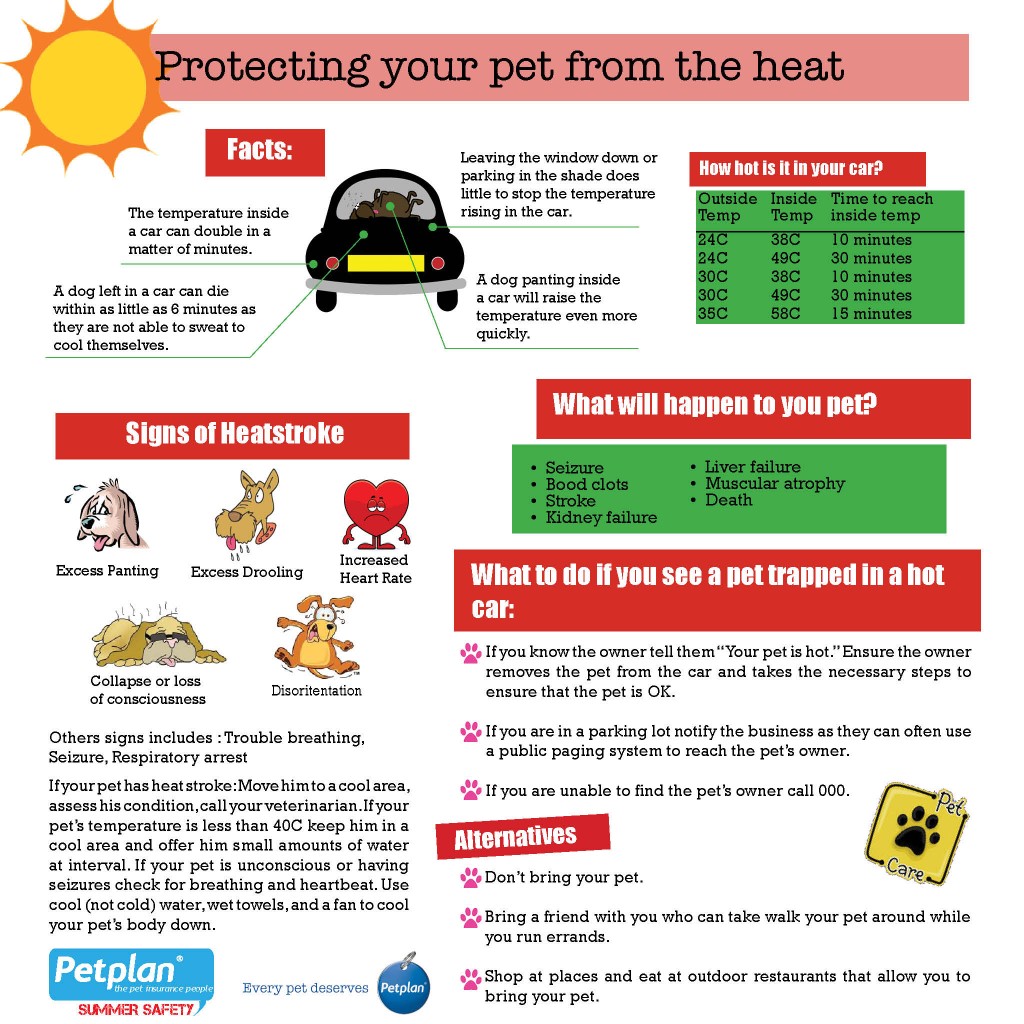The warm weather and sunny days bring great opportunities for you and your pet to enjoy the summer weather. Be sure you keep your pet protected from the sun and the heat as they can both pose a significant threat to your cat and dog.
Avoid the Heat
During the summer months avoiding the heat can require effort and planning. Be sure your pet has access to shade and a fan or air conditioning on a hot day. Remember, if it is too hot for you, it is too hot for your pet!
Heatstroke:
Signs: Excessive panting, excessive drooling, increased heart rate, trouble breathing, disorientation, collapse or loss of consciousness, seizure, respiratory arrest.
If your pet has heat stroke: Move him to a cool area, assess his condition, call your veterinarian. If your pet???s temperature is less than 40C keep him in a cool area and offer him small amounts of water at interval. If your pet is unconscious or having seizures check for breathing and heartbeat. Use cool (not cold) water, wet towels, and a fan to cool your pet???s body down.
Never Leave Your Pet In The Car
Facts:
 The temperature inside a car can double in a matter of minutes.
The temperature inside a car can double in a matter of minutes.- A dog left in a car can die within as little as 6 minutes as they are not able to sweat to cool themselves.
- Leaving the window down or parking in the shade does little to stop the temperature rising in the car.
- A dog panting inside a car will raise the temperature even more quickly.
How hot is it in your car?
Outside Temp?????????????????????????????????????? Inside Temp ?? ?? ?? ?? ?? ?? ?? ?? ?? ?? ?? ?? ?? ?? ?? ?? ??Time Passed
24C???????????????????????????????????????????????????????????????????????????????? 38C???????????????????????????????????????????????????????????????????????????????? 10 minutes
24C???????????????????????????????????????????????????????????????????????????????? 49C???????????????????????????????????????????????????????????????????????????????? 30 minutes
30C???????????????????????????????????????????????????????????????????????????????? 38C???????????????????????????????????????????????????????????????????????????????? 10 minutes
30 C?????????????????????????????????????????????????????????????????????????????? 49C???????????????????????????????????????????????????????????????????????????????? 30 minutes
35C???????????????????????????????????????????????????????????????????????????????? 58C???????????????????????????????????????????????????????????????????????????????? 15 minutes
What will happen to your pet?
Seizure, blood clots, stroke, kidney failure, liver failure, muscular atrophy, DEATH.
What to do if you see a pet trapped in a hot car:
If you know the owner tell them ???Your pet is hot.??? Ensure the owner removes the pet from the car and takes the necessary steps to ensure that the pet is OK.
If you are in a parking lot notify the business as they can often use a public paging system to reach the pet???s owner.
If you are unable to find the pet???s owner call 000.
Alternatives to Keeping your Pet in the Car:
- Don???t bring your pet.
- Bring a friend with you who can take walk your pet around while you run errands.
- Shop at places/eat at restaurants that allow you to bring your pet.

SLIP! SLOP! SLAP!
While your pet may not be able to “slip on a shirt” or “slap on a hat” you can follow the same principle for human sun safety with ??your pet. In the summer months many people want to shave all their pet’s hair or fur to keep them cool but their coat protects them from the sun’s harmful rays so avoid short hair cuts.
Protect your pet with animal safe sunblock. Ask your veterinarian which sunblock he would recommend for your pet and be sure to watch out for ingredients like zinc oxide that are toxic to dogs and cats. Apply sunscreen liberally to your pet’s stomach, ears, noses, and any other place with minimal hair.
If your pet does get a sunburn be sure to treat it properly with a cool, wet towel and a pet safe aloe vera. Check with your veterinarian to see which aloe vera he recommends.
Keep in ??mind that white dogs and cats are especially susceptible to sunburn and that skin cancer is the most common type of cancer in pets.
High Rise Syndrome
When warm weather and beautiful summer breezes are the norm people are more likely to leave the windows in their home open. Whether you live in a one story house or a fifty story apartment building be sure your windows are fitted with the proper safety screens to prevent a potential disaster, especially when you have a cat.
The number of cats that are injured or killed each year after jumping out of an unsecured window is so extraordinary that veterinarians decided to file these types of injuries into their own category: High Rise Syndrome. This “condition” is 100% preventable. Be sure that balconies and windows are completely secured with screens or netting that is cat proof. Child proof window guards do not provide adequate security as many cats can slip past them.
If your Cat Jumps
- Most jumps are actually accidental falls from windows, balconies, or fire escapes.
- Cats typically land on their feet but usually their legs apart. This can cause head or pelvic injuries.
- Never assume your cat has been killed by the fall. There is record of a cat surviving a fall from the 46th floor! If your cat does fall it is likely he will fall into a sidewalk, street, or other unfamiliar territory and will need your help immediately.
- Small falls can be dangerous, too! When a cat falls from less than two stories he often does not have time to twist his body around so that he lands on his feet.
- 90% of High Rise Syndrome cases end in full recovery when veterinary treatment is sought immediately after the fall.





